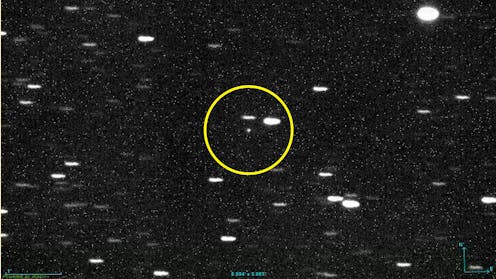
This week, astronomers have identified the third known interstellar visitor to our Solar System, marking a significant milestone in the study of cosmic phenomena. The object, initially detected by the Asteroid Terrestrial-impact Last Alert System (ATLAS) on July 1, has been officially named I3/ATLAS. Experts at NASA’s Center for Near Earth Object Studies and the International Astronomical Union (IAU) have confirmed the object’s interstellar origin.
The discovery of I3/ATLAS is particularly intriguing due to its rapid velocity and unusual orbital path. Current observations indicate it is traveling at approximately 245,000 kilometers per hour, a speed that allows it to escape the Sun’s gravitational pull. For context, an object near Earth’s orbit would need to travel at just over 150,000 kilometers per hour to break free from the Solar System.
Unraveling the Mystery of I3/ATLAS
One of the most compelling aspects of I3/ATLAS is its highly eccentric orbit. Eccentricity measures how “stretched” an orbit is, with a value of 0 indicating a perfect circle. An eccentricity greater than 1 signifies an orbit not bound to the Sun. I3/ATLAS boasts an eccentricity of 6.3, the highest ever recorded for any object within our Solar System, strongly suggesting its interstellar origins.
This discovery follows the identification of two previous interstellar objects. The first, ‘Oumuamua, was spotted in 2017 by the Pan-STARRS1 telescope in Hawaii. It was tracked for 80 days before its interstellar nature was confirmed. The second, comet 2I/Borisov, was discovered in 2019 by amateur astronomer Gennadiy Borisov, with confirmation of its origin taking only a few weeks. In contrast, the interstellar nature of I3/ATLAS was confirmed in just a matter of days.
Origins and Implications
The question of how I3/ATLAS arrived in our Solar System remains a topic of active research. Recent studies published in The Planetary Science Journal suggest that interstellar objects may be more common than previously thought. These objects could originate from nearby star systems, such as Alpha Centauri, our closest interstellar neighbor located 4.4 light-years away.
Alpha Centauri is gradually moving closer to our Solar System, with its closest approach expected in about 28,000 years. If it ejects material similarly to our Solar System, scientists estimate that up to a million objects larger than 100 meters in diameter could already be present in the outer reaches of our Solar System. This number could increase significantly as Alpha Centauri approaches, potentially leading to more frequent interstellar visits.
“While the chance of one of these objects coming close to the Sun is extremely small, the study suggests a few tiny meteors from Alpha Centauri, likely no bigger than grains of sand, may already hit Earth’s atmosphere every year.”
The Future of Interstellar Exploration
Discovering interstellar visitors like I3/ATLAS offers a unique opportunity to glimpse into the wider galaxy. Each confirmed object expands our understanding of these cosmic travelers, their origins, and their journeys through space. The advent of powerful new observatories, such as the NSF–DOE Vera C. Rubin Observatory, is expected to enhance our ability to detect these elusive objects significantly.
During its initial test imaging, the Rubin Observatory revealed 2,104 previously unknown asteroids, showcasing its potential to revolutionize the search for interstellar objects. With its wide field of view and constant sky coverage, Rubin is poised to transform rare discoveries into more routine occurrences.
As for I3/ATLAS, further observations are needed to determine its nature. Currently classified as a comet by the IAU Minor Planet Center, some scientists argue it may instead be an asteroid, roughly 20 kilometers across, due to the absence of typical comet-like features such as a glowing coma or tail.
Presently, I3/ATLAS is inbound, just inside Jupiter’s orbit, and is expected to reach its closest point to the Sun, slightly nearer than Mars, on October 29. It will then swing back towards deep space, making its closest approach to Earth in December, posing no threat to our planet.
Whether it is a comet or an asteroid, I3/ATLAS serves as a messenger from another star system. As next-generation observatories like Rubin come online, the discovery of interstellar companions may become increasingly common, offering new insights into the cosmos.
Kirsten Banks, an academic with no affiliations benefiting from this article, underscores the importance of these discoveries in expanding our cosmic knowledge.







